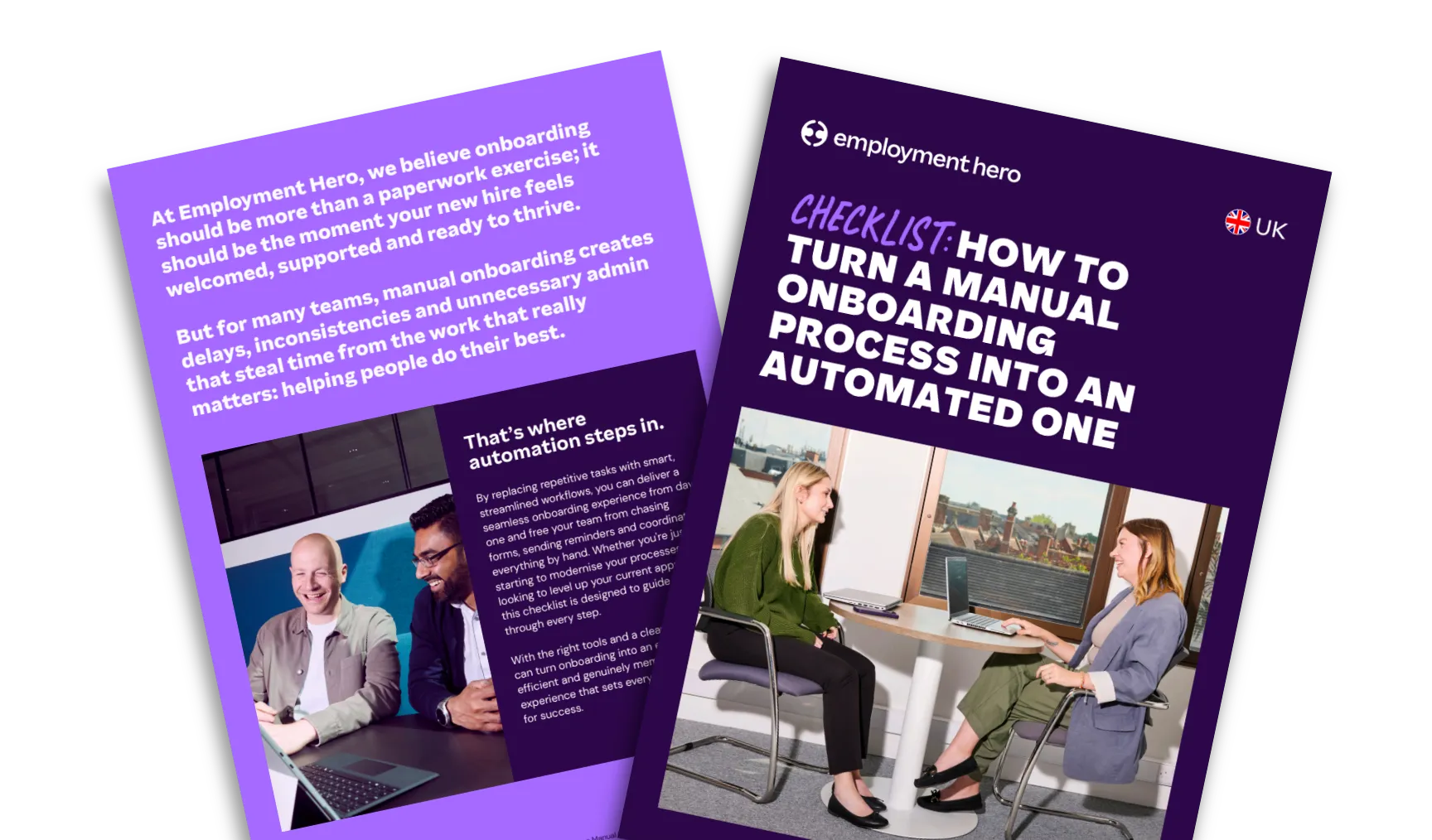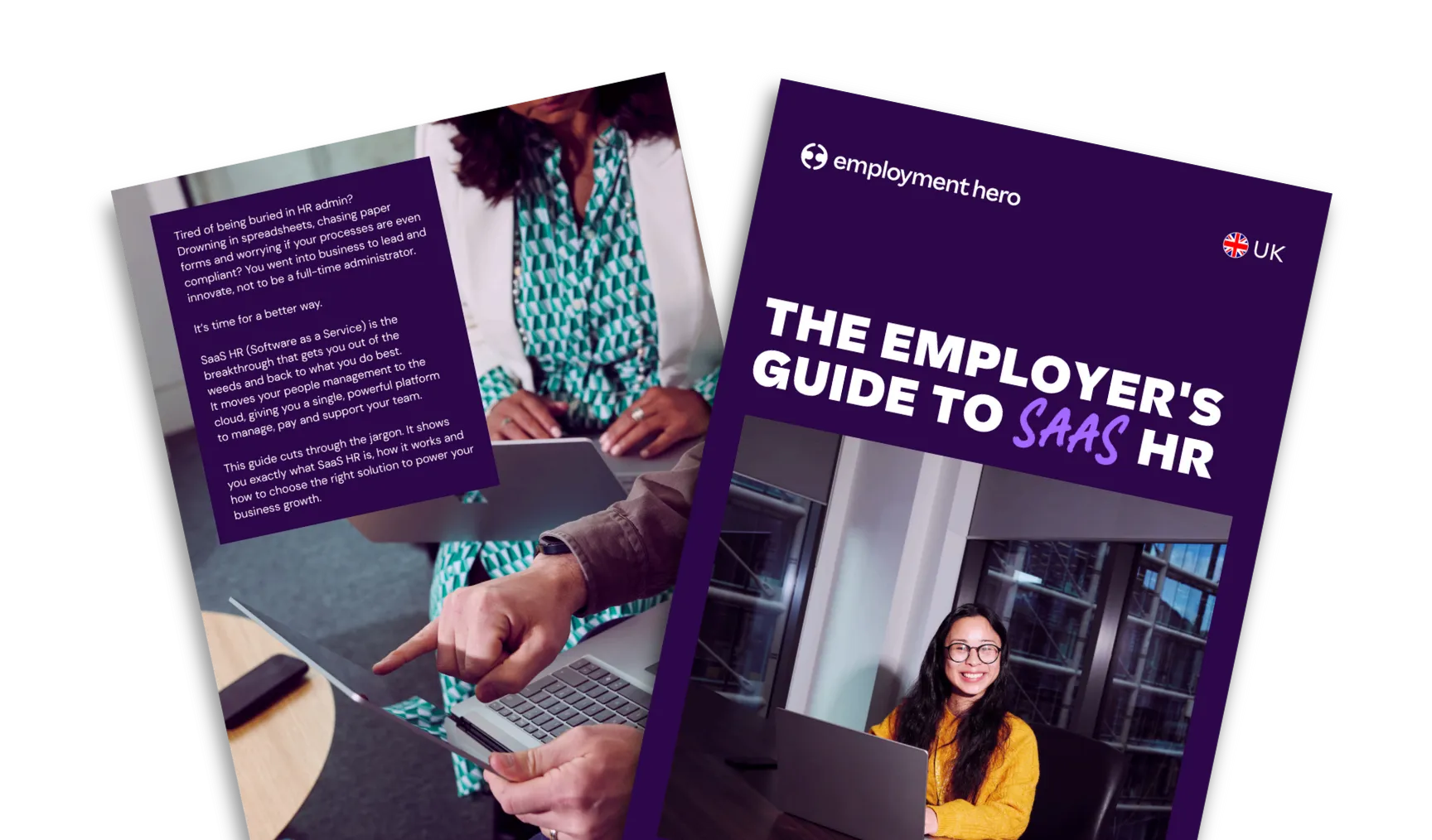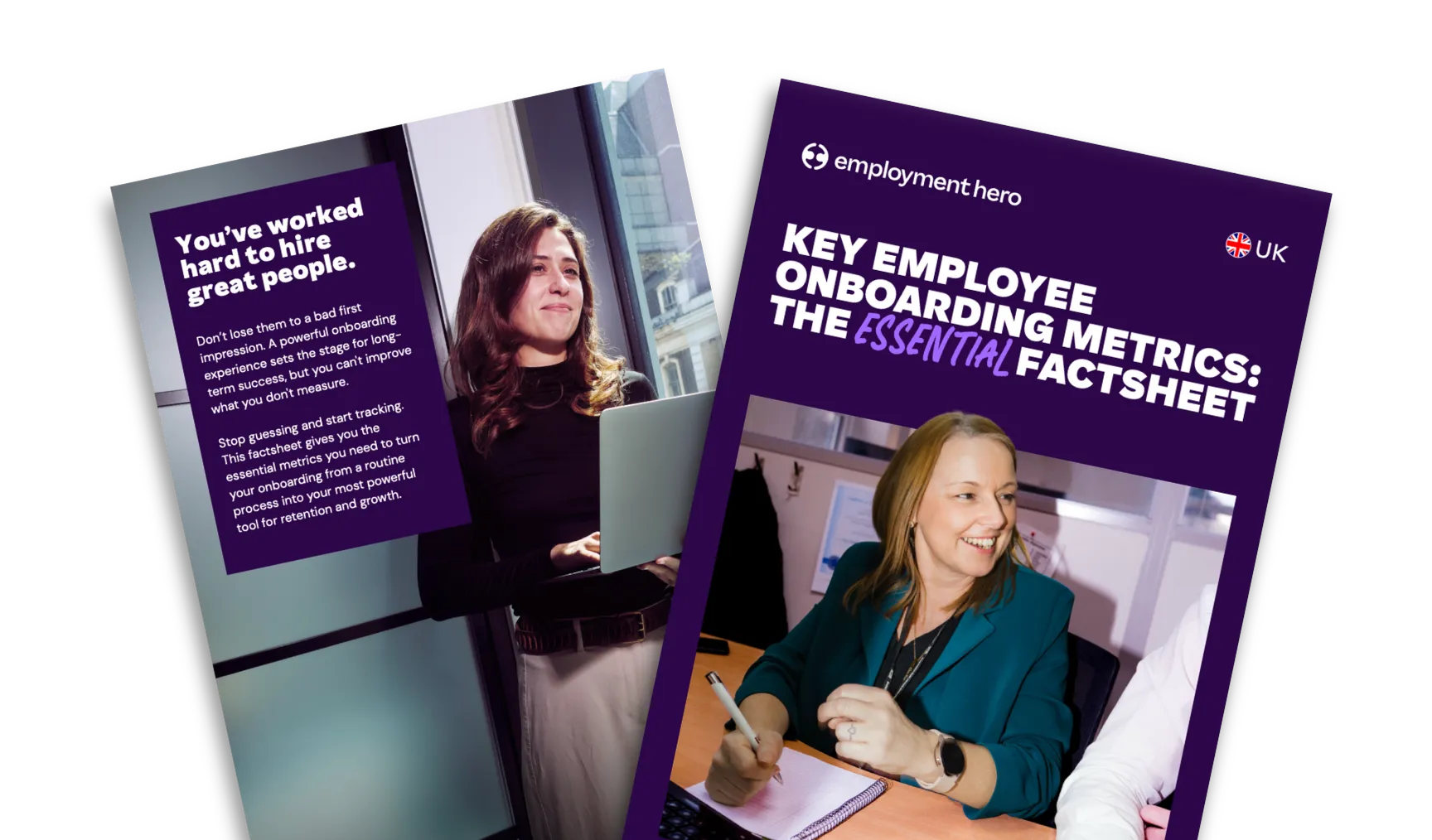Paternity leave: An employer’s guide to rights and pay
Published
Paternity leave: An employer’s guide to rights and pay
Published
When a new baby arrives, it’s not just mothers who need time away from work. Partners play an equally important role in supporting the family and building those early bonds with their baby. This is where paternity leave comes in.
For business owners and HR professionals, paternity leave is more than just a legal requirement. How you handle paternity leave sends a clear message about your culture and how you value your employees. By supporting new parents, you’re showing your team that family matters and that goes a long way in shaping loyalty and engagement.
Here we take a closer look at how paternity leave works in the UK. From eligibility and statutory pay to adoption rights and shared parental leave. We’ll break it all down so you can stay compliant and support your team with confidence.
What is paternity leave?
Paternity leave is statutory time off that allows an employee to support their partner and child following the birth or adoption of a child. It’s specifically designed for fathers, partners of the mother or individuals who have responsibility for raising the child. The goal is to provide space for bonding and care during those crucial early weeks.
Unlike maternity leave, which can last up to 52 weeks, statutory paternity leave is shorter. But despite its length, it plays an essential role in supporting family life and creating an equitable workplace.
Employers should note that paternity leave is distinct from parental leave and shared parental leave. Each has its own rules, entitlements and processes. Having clear policies in place for each helps avoid confusion and demonstrates that you take compliance seriously.
How long is paternity leave in the UK, and what are employees entitled to?
Statutory paternity leave in the UK entitles eligible employees to take up to two weeks off work. This time can be taken as:
- One week.
- Two consecutive weeks.
Leave can be taken as two separate one-week blocks and it must be completed within 56 days of the child’s birth or adoption placement.
To qualify for statutory paternity leave, employees must meet several conditions:
- They must have worked continuously for the same employer for at least 26 weeks up to the 15th week before the baby is due.
- They must still be employed up to the date of the child’s birth or adoption placement.
- They must be the biological father of the child, the spouse, civil partner, or partner of the child’s mother, or someone with official responsibility for the upbringing of the child.
Employers should be aware that employees need to give notice to qualify. Typically, this must be done by the end of the 15th week before the expected week of childbirth. Notice should include the length of leave requested and when the employee intends to take it. Employers may ask for this notice in writing.
For businesses, being transparent about these requirements is essential. Providing employees with clear policies and easy-to-follow processes reduces confusion and shows that you are committed to supporting them.
What are paternity leave rights?
Employees taking paternity leave are protected by several rights under UK law. Employers need to be aware of these to avoid disputes and potential legal claims. The key rights for paternity leave include:
- The right to return to the same job: once paternity leave ends, the employee must be allowed to return to the same job on the same terms and conditions.
- Protection from unfair dismissal: it is unlawful to dismiss or treat an employee unfairly because they requested or took paternity leave.
- Continuity of employment: during paternity leave, employees continue to accrue service. This means their absence counts toward qualifying periods for future entitlements such as redundancy pay, sick pay and pension benefits.
- The right to accrue holiday: statutory holiday entitlement continues to build while an employee is on paternity leave.
You must apply these rights consistently and any deviation could lead to claims of discrimination, which can be costly both financially and reputably. Best practice is to document your company’s approach to paternity leave in your employee handbook. This ensures both managers and employees understand their rights and responsibilities.
Statutory paternity pay and eligibility
In addition to leave, eligible employees may also qualify for Statutory Paternity Pay (SPP).
The basics of SPP:
- It is paid for up to two weeks.
- The current rate is £187.18 per week, or 90% of the employee’s average weekly earnings, whichever is lower.
- Employees must earn at least £125 per week (before tax) to qualify.
- They must meet the same service length requirements as for paternity leave.
Employers are responsible for making these payments, but they can reclaim most, or sometimes all, of the cost from HMRC. Typically, businesses reclaim 92% of SPP, while small businesses may be able to reclaim the full amount plus a small percentage.
Employers should ensure payroll systems are set up to process SPP correctly. Manual calculations can be prone to error, which risks non-compliance and employee dissatisfaction. Using solutions like automated payroll or dedicated payroll software ensures accuracy and saves time.
Attending antenatal or adoption appointments
Employees can take time off work to attend two antenatal appointments during pregnancy, or two adoption appointments for secondary adopters.
While this time off is unpaid by law, paying employees for these appointments can strengthen loyalty and morale. Employers should have clear policies for managing requests to ensure fairness and avoid disputes.
Offering paid leave for appointments can also be seen as an investment in retention, particularly for employees who might otherwise consider their workplace unsupportive.
Holiday entitlement and paternity leave
Holiday accrues during paternity leave. Employees continue to earn their statutory 5.6 weeks’ annual leave.
If the leave year ends while employees are on paternity leave, some unused holiday may carry over depending on company policy. Early planning and communication help ensure fair allocation and minimise scheduling conflicts.
Supporting holiday accrual during paternity leave not only ensures compliance but also reinforces that your business values staff wellbeing, which improves engagement and reduces turnover risk.
Adoption and surrogacy cases
Adoption leave and pay
In the UK, when a child is adopted, the legal framework provides specific entitlements for the adopting parents:
- Adoption leave: The primary adopter is entitled to up to 52 weeks of adoption leave. This comprises 26 weeks of Ordinary Adoption Leave (OAL) and 26 weeks of Additional Adoption Leave (AAL).
- Eligibility for adoption leave: To qualify for adoption leave, the adopter must have been continuously employed by the same employer for at least 26 weeks by the week they are matched with the child (or by the time they are notified of a match in overseas cases).
- Adoption pay: The primary adopter may be entitled to Statutory Adoption Pay (SAP) for up to 39 weeks. To qualify for SAP, the adopter must earn at least £125 per week (before tax) and have been continuously employed by the same employer for at least 26 weeks by the week they are matched with the child (or by the time they are notified of a match in overseas cases).
- Secondary adopter’s entitlements: The secondary adopter, often the partner of the primary adopter, may be entitled to Statutory Paternity Leave and Pay. This includes:
- Statutory paternity leave: Up to two weeks of leave to support the primary adopter.
- Statutory paternity pay: Paid at the statutory rate (currently £187.18 per week or 90% of average weekly earnings, whichever is lower).
Surrogacy arrangements
For parents entering into a surrogacy arrangement, the legal entitlements are as follows:
- Adoption leave and pay: The intended parent who is not the biological parent may be entitled to adoption leave and pay, provided they meet the eligibility criteria. This includes:
- Eligibility for adoption leave: The intended parent must have been continuously employed by the same employer for at least 26 weeks by the 15th week before the expected week of childbirth.
- Adoption pay: The intended parent may be entitled to Statutory Adoption Pay for up to 39 weeks, subject to meeting the eligibility criteria.
- Paternity leave and pay: The intended parent who is the biological parent may be entitled to Statutory Paternity Leave and Pay. This includes:
- Statutory paternity leave: Up to two weeks of leave to support the surrogate and care for the child.
- Statutory paternity pay: Paid at the statutory rate, provided the eligibility criteria are met.
- Shared Parental Leave: In certain circumstances, intended parents may be eligible to share leave and pay through the Shared Parental Leave (SPL) scheme. This allows parents to take up to 50 weeks of leave and 37 weeks of pay between them, subject to meeting the eligibility criteria.
Keeping in touch and returning to work
Even though paternity leave is relatively short compared to maternity or adoption leave, planning how employees stay connected during their absence and how they return to work is crucial for engagement, productivity and retention.
Keeping in touch (KIT ) days
- Agree on communication upfront: Before leave starts, discuss whether the employee wants regular updates about company news, projects, or important decisions. Some employees may prefer complete disconnect, while others appreciate staying informed.
- Use structured updates: Short, scheduled emails or newsletters can keep employees in the loop without overwhelming them. Avoid informal or off-the-record communications that might make employees feel obligated to respond.
- Check in on wellbeing: Leave isn’t just about legal compliance. A simple wellness check-in demonstrates care and helps spot any issues early.
Returning to Work
Returning to work after paternity leave should be smooth and supportive. Consider these best practices:
- Welcome-back meeting: Hold a one-on-one meeting to catch up on changes, projects, or any training requirements that arose during leave. This reassures the employee and reduces anxiety about reintegration.
- Flexible working options: Parents may need time to adjust, so offer flexible schedules or hybrid arrangements if feasible. This can improve retention and morale.
- Update on career progression: Ensure employees know that taking paternity leave will not negatively affect promotions, pay reviews, or performance appraisals. Communicate clearly and consistently.
- Buddy or mentor support: Pair returning employees with a colleague who can provide guidance, answer questions and help reintegrate them into team workflows.
What is shared parental leave?
Shared Parental Leave, or SPL, gives parents more flexibility to share time off following the birth or adoption of a child. It was introduced in the UK to allow mothers, primary adopters, and their partners to divide leave and pay in a way that fits the needs of the family, rather than strictly following traditional maternity or paternity timelines.
Eligible parents can share up to fifty weeks of leave and thirty-seven weeks of statutory pay. This leave can be taken in a single block or divided into multiple periods, giving parents the option to return to work temporarily or work part-time while still caring for their child. SPL can be a practical solution for families wanting to stagger their leave or coordinate responsibilities, and it helps support a more balanced division of childcare duties.
To qualify, both parents must have been continuously employed for at least twenty-six weeks by the relevant qualifying week, and both must earn at least the minimum weekly threshold. Shared Parental Leave can only be taken once the mother or primary adopter has curtailed their maternity or adoption leave.
For employers, SPL requires careful planning to ensure requests are handled fairly and accurately, both for leave approval and pay calculations. Supporting SPL demonstrates a commitment to flexibility, equality, and employee wellbeing. Offering SPL also benefits the business by improving retention, enhancing employer reputation, and promoting gender equality in the workplace.
Download the full guide
Managing paternity leave effectively is more than a legal requirement. It’s an opportunity to demonstrate that your business values employees as people, supports families, and creates a culture of trust and loyalty.
For employers who want a complete, practical resource, our Parents at Work Guide covers everything you need to know about parental leave in the UK. It includes guidance on maternity, paternity, adoption, surrogacy, and shared parental leave, alongside step-by-step instructions for pay calculations, notifications, and compliance checklists.
By using the guide, you can confidently support your team through one of life’s most important milestones while maintaining smooth business operations. It’s designed to help HR professionals and business owners implement fair, compliant, and inclusive parental leave practices. protect your team and create a supportive workplace culture every step of the way.
To download the guide, we just need a few quick details.
Related Resources
-
 Read more: Onboarding Automation: Redefine Your Process With AI
Read more: Onboarding Automation: Redefine Your Process With AIOnboarding Automation: Redefine Your Process With AI
Discover how AI-powered onboarding automation can transform your employee onboarding process. Learn the benefits, challenges and key tasks to automate.
-
 Read more: What is SaaS HR? A comprehensive guide
Read more: What is SaaS HR? A comprehensive guideWhat is SaaS HR? A comprehensive guide
Learn what SaaS HR means, how it works, and why UK employers are switching to cloud-based HR software to streamline…
-
 Read more: Key Employee Onboarding Metrics and KPIs to Track
Read more: Key Employee Onboarding Metrics and KPIs to TrackKey Employee Onboarding Metrics and KPIs to Track
Discover the top onboarding metrics and KPIs every UK employer should track, and how to measure the success of your…



















